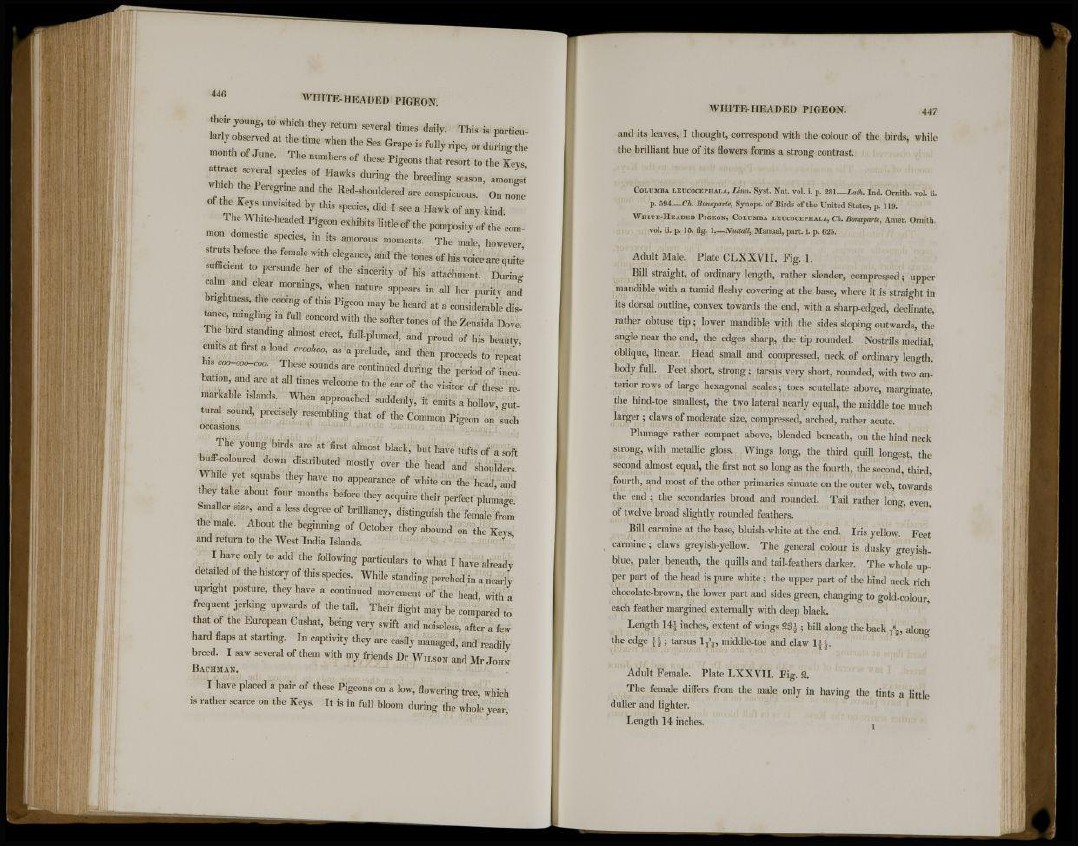
their young, to which they return several times daily. This is particularly
observed at the time when the Sea Grape is fully ripe, or during the
month of June. The numbers of these Pigeons that resort to the Keys,
attract several species of Hawks during the breeding season, amongst
which the Peregrine and the Red-shouldered are conspicuous. On none
of the Keys unvisited by this species, did I see a Hawk of any kind.
The White-headed Pigeon exhibits little of the pomposity of the common
domestic species, in its amorous moments. The male, however,
struts before the female with elegance, and the tones of his voice are quite
sufficient to persuade her of the sincerity of his attachment. During
calm and clear mornings, when nature appears in all her purity and
brightness, the cooing of this Pigeon may be heard at a considerable distance,
mingling in full concord with the softer tones of the Zenaida Dove.
The bird standing almost erect, full-plumed, and proud of his beauty,
emits at first a loud croohoo, as a prelude, and then proceeds to repeat
his coo—coo-coo. These sounds are continued during the period of incubation,
and are at all times welcome to the ear of the visitor of these remarkable
islands. When approached suddenly, it emits a hollow, guttural
sound, precisely resembling that of the Common Pigeon on such
occasions.
The young birds are at first almost black, but have tufts of a soft
buff-coloured down distributed mostly over the head and shoulders.
While yet squabs they have no appearance of white on the head, and
they take about four months before they acquire their perfect plumage.
Smaller size, and a less degree of brilliancy, distinguish the female from
the male. About the beginning of October they abound on the Keys,
1 TXT T 1* X I 1
and return to the West India Islands.
I have only to add the following particulars to what I have already
detailed of the history of this species. While standing perched in a nearly
upright posture, they have a continued movement of the head, with a
frequent jerking upwards of the tail. Their flight may be compared to
that of the European Cushat, being very swift and noiseless, after a few
hard flaps at starting. In captivity they are easily managed, and readily
breed. I saw several of them with my friends Dr WILSON and Mr JOHN
BACHMAN.
I have placed a pair of these Pigeons on a low, flowering tree, which
is rather scarce on the Keys. It is in full bloom during the whole year,
WHITE-HEADED PIGEON. 447
and its leaves, I thought, correspond with the colour of the birds, while
the brilliant hue of its flowers forms a strong contrast.
COLUMBA LEUCOCEPHALA, Linn. Syst. Nat. vol. i. p. 281.—Lath. Ind. Ornith. vol. ii.
p. 594 Ch. Bonaparte, Synops. of Birds of the United States, p. 119.
WHITE-HEADED PIGEON, COLUMBA LEUCOCEPHALA, Ch. Bonaparte, Amer. Ornith.
vol. ii. p. 15. fig. 1.—Nuttall, Manual, part. i. p. 625.
Adult Male. Plate CLXXV1I. Fig. 1.
Bill straight, of ordinary length, rather slender, compressed; upper
mandible with a tumid fleshy covering at the base, where it is straight in
its dorsal outline, convex towards the end, with a sharp-edged, decimate,
rather obtuse tip; lower mandible with the sides sloping outwards, the
angle near the end, the edges sharp, the tip rounded. Nostrils medial,
oblique, linear. Head small and compressed, neck of ordinary length,
body full. Feet short, strong ; tarsus very short, rounded, with two anterior
rows of large hexagonal scales; toes scutellate above, marginate,
the hind-toe smallest, the two lateral nearly equal, the middle toe much
larger ; claws of moderate size, compressed, arched, rather acute.
Plumage rather compact above, blended beneath, on the hind neck
strong, with metallic gloss. Wings long, the third quill longest, the
second almost equal, the first not so long as the fourth, the second, third,
fourth, and most of the other primaries sinuate on the outer web, towards
the end ; the secondaries broad and rounded. Tail rather long, even,
of twelve broad slightly rounded feathers.
Bill carmine at the base, bluish-white at the end. Iris yellow. Feet
carmine ; claws greyish-yellow. The general colour is dusky greyishblue,
paler beneath, the quills and tail-feathers darker. The whole upper
part of the head is pure white; the upper part of the hind neck rich
chocolate-brown, the lower part and sides green, changing to gold-colour,
each feather margined externally with deep black.
Length 14| inches, extent of wings 9S\ ; bill along the back T
8
3 , along
the edge \ \ ; tarsus 1TV? middle-toe and claw \ \ \ .
Adult Female. Plate LXXVII. Fig. %
The female differs from the male only in having the tints a little
duller and lighter.
Length 14 inches. l